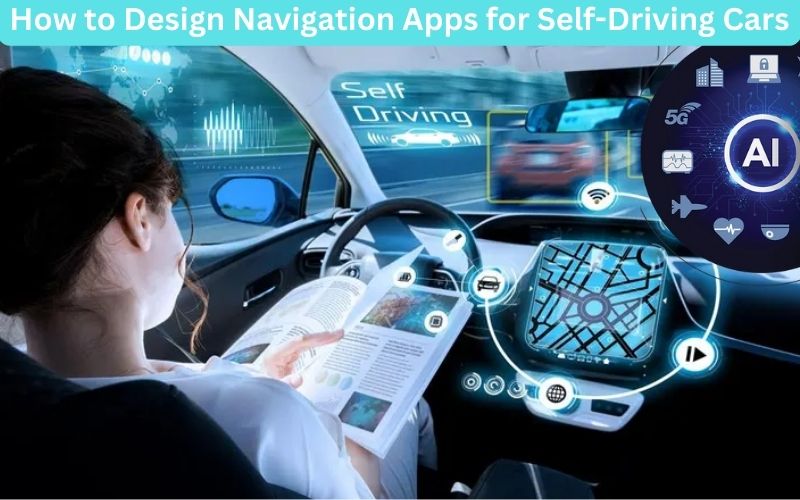
The arrival of self-driving vehicles will inevitably increase the need for navigation applications that can guide them securely and effectively. Companies specializing in mobile app development are at the forefront of this innovation. However, creating applications that can employ the newest tools to provide users of self-driving cars with the greatest experience.
In this blog article, we’ll go over the advantages of self-driving applications, and why it’s crucial to create them. Additionally, we will discuss the difficulties that must be solved and the crucial design factors for effective self-driving guidance apps.
Benefits of Self-Driving Applications
- Enhanced Safety
Safety is king in the world of self-driving automobiles. These autonomous cars continually examine their surroundings thanks to various sensors, including radar, LiDAR, and cameras. Analyzing this real-time data by navigation applications enables self-driving vehicles to make split-second judgments that put safety first. These programs may drastically minimize accidents by removing human error, saving countless lives.
- Optimal Routes
Imagine a navigation app that shows you the fastest path and accounts for current traffic, road conditions, and even weather predictions. Self-driving applications can do this. These programs can optimize routes in ways that human drivers can only imagine since they can access much data, such as traffic patterns and historical data. Time is saved, traffic is eased, and carbon emissions are decreased.
- Improved Traffic Flow
Imagine a traffic dance in which the flow of vehicles is maintained by automobiles altering their speed and trajectory in unison. This may become a reality with self-driving automobiles. These cars can coordinate their movements by communicating easily with one another, which lessens abrupt lane changes and quick braking. At the center of this coordination, navigation applications ensure that the complex dance of self-driving automobiles stays elegant and effective.
- Accessibility
Self-driving application development is paving the way on the technological path to inclusion. Self-driving vehicles with user-friendly guidance applications might revolutionize transportation for those with disabilities. Going around city streets, performing errands, and visiting loved ones is feasible and empowering. This newly discovered mobility has the power to alter lives and communities.
Reasons to Develop Self-Driving Applications
The rapid evolution of technology and changing transportation landscape underscore the importance of developing navigation apps tailored to self-driving cars. Here’s why:
- Future of Transportation: Self-driving cars are not just a futuristic concept; they represent the inevitable evolution of transportation. Designing navigation apps for these vehicles is crucial in preparing for the future.
- Technological Advancements: The progress in AI, sensor technology, and connectivity has paved the way for more sophisticated navigation systems. These advancements enable self-driving cars to navigate complex environments with ease.
- Environmental Impact: Self-driving apps can contribute to environmental sustainability by optimizing driving patterns, reducing fuel consumption, and lowering emissions.
Challenges to Overcome
While the potential of self-driving navigation apps is immense, some challenges need to be addressed to ensure their seamless integration into the transportation ecosystem:
- Complex Environments: Navigating through dynamic and unpredictable urban environments requires navigation apps to process vast amounts of data in real time and make split-second decisions.
- Human Interaction: Interacting with pedestrians and human-driven vehicles presents a unique challenge for self-driving cars. Ensuring safe and efficient communication is essential.
- Technical Hurdles: Achieving the accuracy, reliability, and real-time processing required for self-driving navigation apps demands cutting-edge technology and robust systems.
- Legal and Ethical Considerations: The development of self-driving navigation apps also raises legal and ethical questions, such as liability in case of accidents and ethical decision-making algorithms.
Designing Navigation Apps for Self-Driving Cars
The design of navigation apps for self-driving cars requires a careful blend of advanced technology, user-centric design principles, and safety considerations:
- Advanced Mapping: Accurate and up-to-date mapping data is the cornerstone of self-driving navigation apps. Detailed maps ensure that the vehicle is aware of its surroundings at all times.
- Sensor Integration: Integrating advanced sensors like Lidar, radar, and cameras enables self-driving cars to perceive their environment and respond to real-time changes.
- Machine Learning Algorithms: Machine learning is pivotal in enabling self-driving apps to adapt to changing road conditions, traffic patterns, and unexpected situations.
- Human-Fallback System: While self-driving cars aim to operate autonomously, having a human-fallback system in place is crucial for emergencies or situations beyond the scope of AI.
- User Interface: The user interface of these apps should prioritize clarity and minimize distractions. Information should be presented intuitively, ensuring that users can trust and understand the decisions made by the self-driving system.
Nutshell
Designing navigation apps for self-driving cars is an exciting challenge that requires a deep understanding of user needs, vehicle capabilities, and safety considerations. As autonomous vehicles become a common sight on the roads, navigation apps will play a pivotal role in enhancing passenger experiences and optimizing journeys.
Working with a mobile app development company will help you bridge the gap between cutting-edge technology and user-centric design in this quickly changing environment. This can help you create a future where self-driving apps completely reimagine how people move on our roadways.